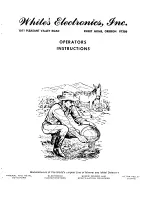
6
Detecting Gas Saving Lives
English
2. Installation
WARNING
• This detector is designed for use in Zone 1 and Zone 2 hazardous areas.
Certification is dependent upon the accessories fitted and ambient operating
temperature. Please refer to the specifications table on page 15 for
certification details. Installation must be in accordance with the recognised
standards of the appropriate authority in the country concerned.
• For further information please contact Crowcon. Prior to carrying out any
installation work ensure local regulations and site procedures are followed.
• The equipment must be earthed using the cable gland and steel armoured cable.
• Do not attempt to fit an IR Display to an IRmax not supplied for the purpose.
Detectors supplied for use with a display are certified Exd ia, and must be
operated either with a Fixed Display containing an IS barrier, or with a Remote
IR Display or IS Hand-Held Calibrator connected via a Crowcon IS Barrier module.
• Detectors supplied without a display are certified Exd IIC and cannot be retro-
fitted for use with an IR Display.
2.1 Location
The
IRmax
should be mounted where the gas to be detected is most likely to be present.
The following points should be noted when locating gas detectors:
•
To detect gases which are lighter than air, such as methane, detectors should be
mounted at high level. To detect heavier-than-air gases, such as flammable vapours,
detectors should be mounted at low level.
•
When locating detectors consider the possible damage caused by natural events
e.g. rain or flooding. For detectors mounted outdoors in very hot regions
Crowcon
recommend the use of a sunshade (see Section 5, Accessories and spare parts,
on
•
Consider ease of access for functional testing and servicing.
•
Consider how the escaping gas may behave due to natural or forced air currents.
Mount
IRmax
in ventilation ducts if appropriate (see Section 5, Accessories and spare
on page 16).
•
Consider the process conditions. For example, butane is normally heavier than air, but
if released from a process which is at an elevated temperature and/or pressure, the
gas may rise rather than fall.
The placement of sensors should be determined following advice of experts having specialist
knowledge of gas dispersion and the plant processing equipment as well as safety and
engineering issues.
The agreement reached on the locations of sensors should be recorded.











































